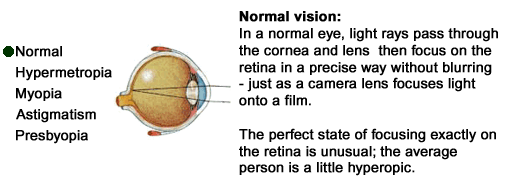
|
|
Objectives
Refractive Error
Refractive error is a term that is used to describe the inability of images to be focussed properly on the retina. The goal of glasses, contact lenses and some surgical treatments is to correct or improve these errors by helping images to focus close to or onto the retina. Refractive errors include myopia, hypermetropia, astigmatism and presbyopia.
Simulation 
Help
WHO definition of low vision
The following is the World Health Organisation's definition of low vision. This is widely used internationally.
A person with low vision is one who has impairment of visual functioning even after:
treatment, for example an operation and/or standard refractive correction (has been given glasses or lenses)
and has a visual acuity of less than 6/18 to light perception, or
a visual field of less than 10° from the point of fixation (i.e. 20° across)
but who uses, or is potentially able to use, vision for the planning and/or execution (doing it!) of a task
Note: People with refractive error are often thought to have low vision if they are not wearing their spectacles or contact lenses. For example: if a person's visual acuity improves from 6/24 to 6/9 with their glasses, they are not considered to have low vision. However, it is also important to note that not everyone with refractive error (i.e. myopia, hyperopia, astigmatism or presbyopia) can have their vision fully corrected.
What is another name for shortsighted?
|
|